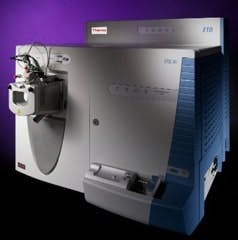Thermo Fisher Scientific Inc. unveiled the Thermo Scientific LTQ XL linear ion trap mass spectrometer equipped with Electron Transfer Dissociation (ETD). This innovative ion fragmentation technology provides important new peptide structure information not available from conventional dissociation methods. The addition of ETD to the LTQ XL linear ion trap mass spectrometer provides significant advantages for protein/peptide characterization, post-translational modification (PTM) analysis and top-down or middle-down sequencing of proteins and peptides. The LTQ XL with ETD option won a Silver Award as one of the best new products seen by industry editors attending Pittcon 2007.
ETD technology takes advantage of the huge ion storage capacity and fast cycle times of Thermo Scientific linear ion trap Technology, allowing researchers to conduct rapid, alternating collisionally induced dissociation (CID) and ETD scanning throughout the LC/MSn analysis of complex samples, in a way that is not possible on three-dimensional ion traps. A new version of BioWorks software streamlines the processing of ETD data. CID and ETD spectra are searched independently, with results from both searches combined for easy comparison and sorting. This new system provides the most complete view of a proteome possible.
The combination of LTQ XL and ETD technology produces sensitive, stable, robust ETD spectra using reagent anions generated in a CI source mounted at the back of the linear ion trap. ETD produces c- and z-type peptide fragment ions, complementing the y- and b-type fragments generated during traditional CID of peptides by ion trap analysis. This additional information allows for more complete characterization of peptides and proteins than is possible with CID alone. In addition, ETD technology is a powerful tool for the analysis of post-translational modifications ETD fragmentation leaves these modifications intact, rather than causing neutral loss events commonly seen with CID analysis of phosphopeptides. PTMs can be identified directly with a new level of confidence.
ETD is just one type of useful ion-ion reaction that can be performed, according to the company; the ETD source option hardware supports multiple ion-ion reaction types, including proton transfer reaction (PTR).





